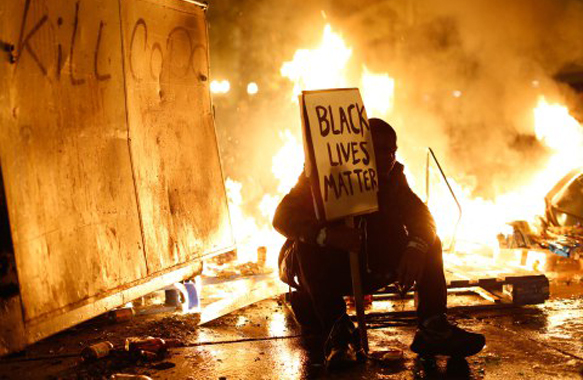By Heather Ann Thompson | Originally Published at Huffington Post. April 28, 2015 2:18 PM EDT Updated: April 28, 2015 2:59 PM EDT | Photographic Credit; Unknown Source/Social Media
As most Americans were sitting down to dinner Monday night, Maryland’s Governor Larry Hogan was declaring a state of emergency in the city of Baltimore. Baltimore was burning, he explained, and nothing short of calling out the National Guard could now bring calm to Charm City. Mere minutes later, CNN, NPR and myriad other media outlets were reporting on the chaos. No matter how many mea culpas the Baltimore Police Department had offered, and no matter what assurances it had given that a thorough investigation into the death of 25-year-old Freddie Gray would be conducted, city residents couldn’t be calmed.
And yet, can state officials or the media really be surprised that promises of an internal investigation don’t appease? Have they forgotten that citizens have directed their attention again and again to the crisis of police misconduct and abuse without remedy? Can they not remember the myriad instances of police violence against ordinary citizens that even they have acknowledged when they paid out millions of dollars in restitution to the victims? Indeed, as the Baltimore Sun reported just seven months ago, complete with graphic photographs of seriously injured citizens from that city, city officials have paid out over $5.7 million dollars to such victims since 2011. And, it turns out, they got off cheap. The state of Maryland has a cap on what it could be forced to pay out of a mere $200,000 per incident.
Even if state officials can’t really grasp why Baltimore is burning today, they would do well to take a bit of a step backward and consider why their city burned before — back in 1968. They might discover, albeit with some surprise, that then, like now, black residents erupted only because they were bone-sick of hearing news that yet another black man had been killed in America. They might see that the true state of emergency now, like then, isn’t rage or even rock throwing. It is the racial profiling and racial brutality of the police.
Indeed, this state of emergency — the true state of emergency — has a very long national history. Back in 1967, for example, when Detroit was in flames and its black citizenry also took to the streets in rage and despair, Michigan’s Governor George Romney also declared a state of emergency. He also called in the National Guard. And, most importantly, he also misunderstood the true state of emergency that his city faced.
Then, like now, the real emergency wasn’t the smashing glass nor the fires. That would all end soon enough.
The real crisis that Romney faced — indeed the real state of emergency facing his constituents — was the fact that the Detroit Police Department had been abusing black citizens without censure for decades. The real state of emergency was that black lives didn’t matter enough in Detroit.
And this is the real crisis that Governor Larry Hogan and every other American governor now faces as well. America’s real state of emergency is that black citizens keep getting wounded, maimed and killed by members of law enforcement. These are real women like Rekia Boyd and Aura Rosser. These are real girls like Aiyana Stanley-Jones . These are real men like Walter Scott and Eric Garner. These are real boys like Tamir Rice and Vonderitt Meyers.
America’s real state of emergency remains that black lives still don’t matter enough in cities across America.
Dr. Heather Ann Thompson is a native Detroiter and historian at Temple University who has written numerous popular as well as scholarly articles on the history of mass incarceration as well as its current impact. These include pieces for the New York Times, The Atlantic, Salon.com, Dissent, and New Labor Forum, as well as the award-winning articles: “Why Mass Incarceration Matters: Rethinking Crisis, Decline and Transformation in Postwar American History” and “Rethinking Working Class Struggle through the Lens of the Carceral State: Toward a Labor History of Inmates and Guards.
Thompson recently served on a National Academy of Sciences blue-ribbon panel that studied the causes and consequences of mass incarceration in the U.S. and serves as well on the boards of several policy organizations including the Prison Policy Initiative the Eastern State Penitentiary, a historic site, and on the advisory boards of Life of the Law. She also works in an advisory capacity with the Center for Community Change and the Open Society Foundation on issues related to work. On the scholarly front, Thompson recently was honored to be named a Distinguished Lecturer by the Organization of American Historians and, in addition to recently completing Blood in the Water: the Attica Prison uprising of 1971 for Pantheon books, Thompson is also the author of Whose Detroit: Politics, Labor and Race in a Modern American City as well as the edited collection, Speaking Out: Protest and Activism in the 1960s and 1970s. She has also consulted on several documentary films including Criminal Injustice at Attica. In 2015 Thompson joins the faculty at the University of Michigan. | Follow Heather Ann Thompson on Twitter @hthompsn
This piece was reprinted by EmpathyEducates with permission or license. We thank the Author, Professor Heather Ann Thompson for her kindness, observations, research and what we believe is a vital reflection.












Leave A Comment